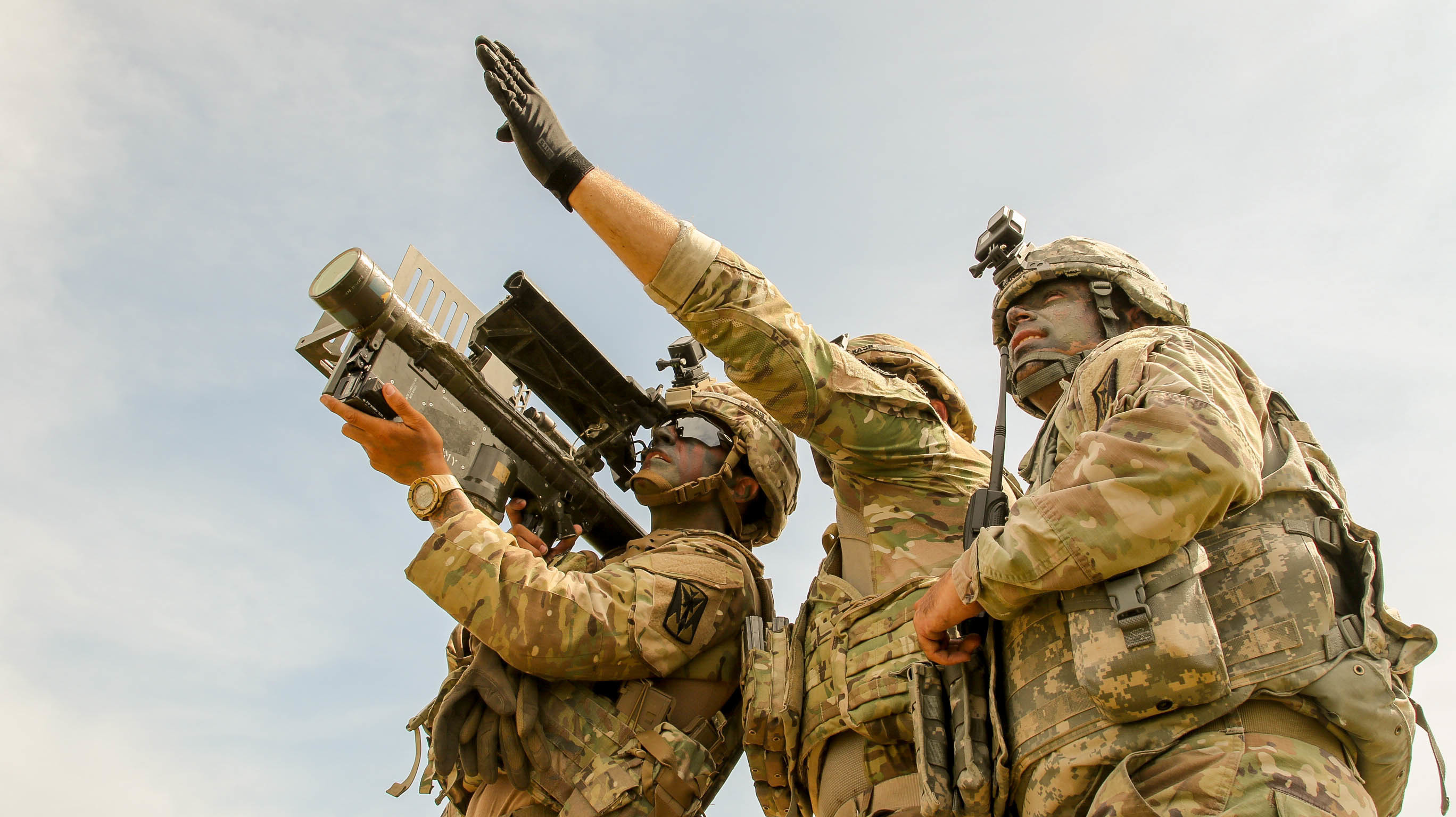Combined Arms Doctrine - This article requires additional citations for validation. Please help make this article better by adding citations to specific sources. Free material can be challenged and removed. I found sources: "Arms drawn" - news · newspapers · books · scholars · JSTOR (April 2009 ) (Learn how and where to remove this page)
Composite weapons are a military strategy that aims to combine different military weapons to achieve complementary effects (for example, using infantry and weapons in an urban environment where each supports the other).
Combined Arms Doctrine

According to General William S. Lindus, combined arms can be distinguished from the concept of "auxiliary arms" in this way:
Us To Train More Ukrainian Troops In Germany On Advanced Battle Tactics
Weapons combined with two or more weapons strike at once so that the actions of one to defend himself make him more vulnerable to the other. On the other hand, two or more weapons strike forward with a point, or if simultaneously, in such a combination that, after conducting actions, it defends itself from the other, and also defends itself from the other.[2]
Although the lower echelons of the combined arms forces are of a similar type, the mixed temperament of such units is assembled into a more effective higher echelon unit, either formally in a board of organization or intimately in a solution to this battle. doubt For example, an armored division, the modern paragon of combined arms doctrine, consists of a mixture of infantry, tanks, artillery, reconnaissance and helicopters, all of which are integrated and managed through a single unit structure.
Most modern military units, if the situation arises, can call on several military branches, such as infantry bombing or military shields or naval forces requesting to attack their land or defend their forces. The mixing of arms is sometimes pushed to a field where homogeneity generally prevails, such as the temporary company of a tank attached to speared infantry.
Composite weapons harken back to ancient times, when armies developed shields from shields to protect the spear in close combat. However, especially among the Greek hoplites, the focus of military thought was almost exclusively on the infantry. In more detailed missions, the armies of different nations have different combinations of light, medium, heavy infantry, cavalry, chariots, camels, elephants, and artillery (mechanical weapons). Combined arms is at this point to use as much cooperating units as possible, variously armed with weapons, lances or missile weapons to arrange the attack and destroy it.
United States Army Combined Arms Support Command
Philip II of Macedon procured most of the small arms of the Greek states, and joined the new Macedonian phalanx with cavalry and other large forces. he secured the phalanx, as far as the cavalry could break through and break the line of the place where they had been formed.
The pre-Marian Roman legion was heavily armed and had five asses. They made light-armored sailors armed with light spears. The spearmen and the leaders of the legion were driven to the ground with their iron helmets; The fifth class of cavalry was for scouting, pursuing, and guarding the flanks.
After the Mariana reforms, the legion was a single heavy infantry armed only with steel and iron, equipped with small artillery and missile auxiliaries, and a small number of cavalry. a legion also sometimes joined arms obliquely with the superior; at one time it was customary for the leader to join two legions and two in likeness of auxiliaries, the lighter ones being useful for skirmishes or for fighting on steep slopes. local

The Han dynasty army is also an example, with melee infantry, ballista and cavalry (from horse archers to heavy lancers).
A Historical Look At Close Air Support (cas): Case Studies Of World War Ii, Korea,...
Civilizations such as the Carthaginians and the Sassanids were also known to have mixed infantry supported by strong cavalry.
At the Battle of Hastings (1066) the footmen fighting behind the shield wall were brilliantly defeated by a Norman army composed of archers, footmen (pedestrians), and horsemen (horsemen). One strategy used by the Normans was to try to leave the glish from the shield wall to attack the retreating Norman infantry only to destroy the op cavalry. Even the Scots' barracks, which were built to bear the burdens of heavy cavalry, and which they successfully used against the splendid cavalry at the Battle of Striveling Bridge (1297), were destroyed at the Battle of Falkirk (1298) by the splendid archery of a single cavalry unit. Both Hastings and Falkirk showed how combined arms could defeat those who relied on one arm only.
The magnificent victories of the Crecians, the Picts, and Agincourt are examples of the simple form of combined arms, with the composition of mounted cavalry forming the basis for the formation of glish lengths. A long, poorly fortified Frch was able to depose its opponents at a distance, while armed with m-weapons could deal with any Frchm that reached the spherical lines. This is the principle of combined arms: to allow them to do together with their combined forces what they cannot do alone from their constitutions.
In the Middle Ages, combined military forces were used as a means to win battles and advance the long-term goals of a war or king. Some historians claim that there was no strategic or tactical art in the Middle Ages.
The Art Of Combined Arms Tactic At Tier 6
In pursuit of the leader's goals and self-interested thinking, a strategic and strategic approach was used with the exploitation of terrain and weather in choosing where and where to fight. The simplest example is the combination of special distinctions, such as archers, infantry, cavalry (soldiers or mounted infantry), and the peasant militia. Sometimes each force fights alone and wins or loses according to the opposing military competition. In the Middle Ages, Magistrates used these specialized forces to win battles. An army that has many resources available may have a larger force that includes one or two troops.
Each type of military formation, infantry, archers, cavalry, or peasants, has certain advantages that others do not. It makes the infantry a force to hold back, and in the majority of the army the troops retreat through places which the cavalry cannot easily maneuver, denying the advantage of the cavalry. Archers shoot bows or crossbows. The horsemen were able to run faster and made a quick attack before the fortifications were ready. Farmers are more and cheaper in the treasury area. Over time, the army can cross over and learn special skills to increase combat effectiveness. It is known today as a battle multiplier. The combination of different leads helps the leader provide flexibility to minimize risk when arriving at gagemts. The ultimate goal of any military operation is to fight and win, with even more fighters to carry out the king's larger strategic goals. This can be seen in some medieval gagemts.
The effective use of combined arms can - combined with strategic and military considerations - overcome opposing forces, even more. The use of terrain and weather can also help in combining weapons to achieve the desired effect of an army commander.

In the middle of 12246, at the battle of Crecy--Ponthieu, a formidable army of between 3,000 and 20,000 mixed soldiers established a line of defense against the approaching French forces of about 100,000 mixed soldiers. The Glissi, who were in the garrison, dismounted the cavalry to augment the infantry forces in the fortification. Archer's place glish does not consist of springs, or sides interspersed with lines, or behind lines. But it was generally scarred by the sides of the previous battles. As soon as they arrived in the battle, they put forward the ballista before the horsemen, so that they might attack the burning battle. The effectiveness of the crossbow is limited by rain-soaked crossbow strings, reducing their effectiveness. Glish archers kept dry bowstrings and only drew them when the crossbowman was out. Thence to the slaughter of the ballista, and the shelter of the survivors, he escaped from the approaching cavalry of Fr. He also tarried unprepared horsemen for a long journey through the field. Little by little the attacks of the French forces lead to a great victory.
Improving The Battle Rhythm To Operate At The Speed Of Relevance > National Defense University Press > News Article View
In 1335, the Helvetii peasants, archers, and infantry went to Morgart to ambush a larger Austrian force. The Swiss rebelled
Combined arms command, combined arms center, combined arms battalion, combined arms dcs, combined arms game, combined arms exercise, dcs combined arms manual, combined arms team, combined arms training strategies, joint operations combined arms, combined arms training center, combined arms

0 Comments